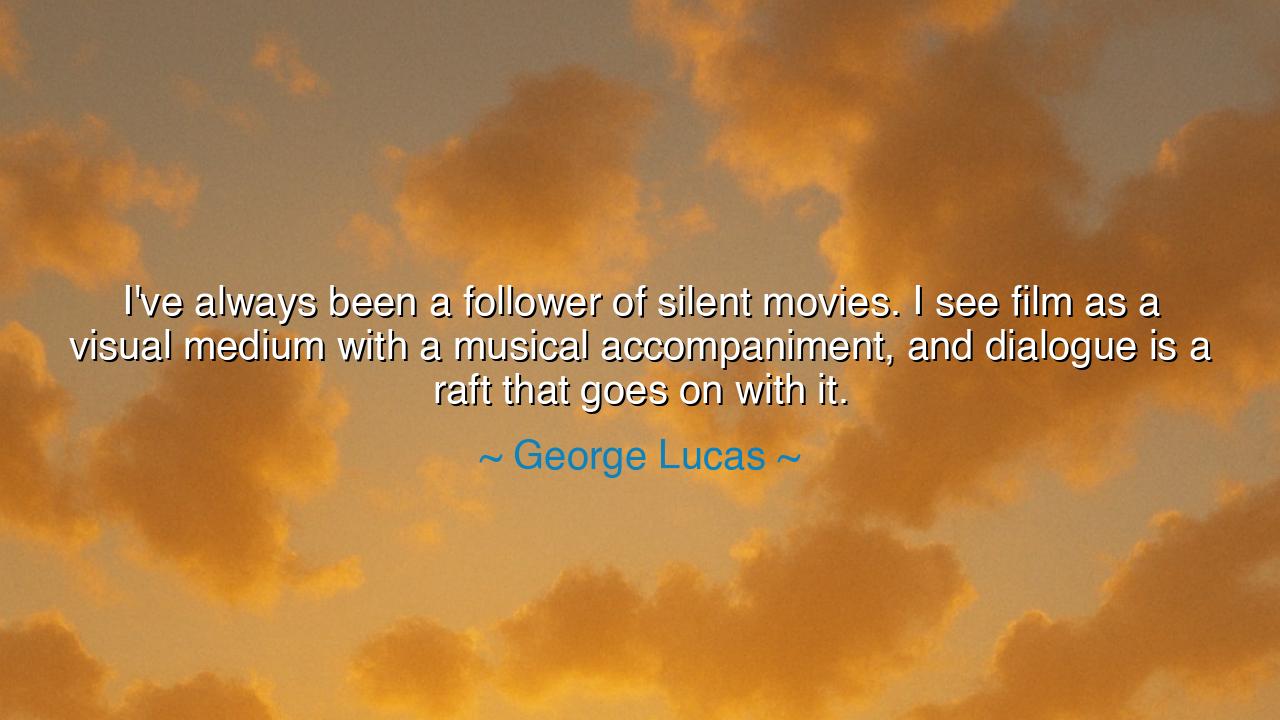
I've always been a follower of silent movies. I see film as a
I've always been a follower of silent movies. I see film as a visual medium with a musical accompaniment, and dialogue is a raft that goes on with it.






Gather close, children of the future, for the words of those who create art and shape the world with their visions carry with them great truths. George Lucas, the master of the silver screen and creator of worlds, once spoke: "I've always been a follower of silent movies. I see film as a visual medium with a musical accompaniment, and dialogue is a raft that goes on with it." These words, simple yet profound, speak of a truth that transcends the boundaries of cinema and touches upon the very nature of expression, communication, and art itself. To understand Lucas's vision is to understand the power of visual storytelling and the delicate balance between sound and silence in our lives.
In the world of silent films, there were no spoken words to carry the weight of the story. The actors spoke not with their voices, but with their eyes, their gestures, their expressions. The film itself became a language, a way of communicating deep emotions and complex narratives without uttering a single word. The silent film was a pure form of art, untainted by the constraints of language, and it spoke directly to the soul. Lucas’s admiration for this medium reflects a deep understanding of the power that images alone hold—a power that transcends words and speaks to the universal human experience.
Consider the example of Charlie Chaplin, the great silent film comedian. Chaplin’s genius lay in his ability to convey profound emotion and social commentary without uttering a word. His iconic film, The Kid, tells the tale of a poor tramp and an orphaned child, a story filled with heartbreak, comedy, and hope—yet all of it unfolds without the use of spoken dialogue. Chaplin’s performance was a masterclass in visual storytelling, where every gesture, every movement, and every expression spoke louder than words ever could. In the silent film era, the visual medium was king, and dialogue was merely a supporting actor in the grand drama of human emotion and experience. Lucas's reverence for this simplicity in the art form is clear—he sees film as a visual language first and foremost, with sound and dialogue merely accompanying it, much like the musical score that swells in the background.
The musical accompaniment that Lucas speaks of is vital to this visual storytelling. Music, like the silent images, carries a deep emotional resonance that words alone cannot convey. In ancient times, the bards of old would sing of the great heroes and battles not just with their voices, but with the powerful music that accompanied their tales. The sound of the lyre, the drum, the flute—each instrument played a role in enhancing the story, making it not only a narrative but a full experience. In the same way, film uses music to amplify the emotions of the scene, adding layers of meaning that dialogue alone cannot provide. Lucas’s view of film as a symphony emphasizes that true storytelling is not simply about words, but about creating a harmonious blend of visuals and sound that speaks directly to the heart.
But the raft of dialogue, as Lucas calls it, serves an essential role. Just as a raft provides support and direction, dialogue gives structure to the story. It helps to clarify the intentions of the characters, to reveal their inner struggles, and to guide the audience through the emotional landscape of the film. Yet, Lucas’s wisdom lies in his recognition that dialogue should not dominate; it should flow alongside the visuals, enhancing the narrative without overshadowing the powerful language of images. True art, in this sense, is about balance—the balance between what is said and what is shown, between what is heard and what is felt. The dialogue, while essential, is secondary to the visual language of the film itself, just as the words spoken in an epic are secondary to the sacrifice and triumph of the heroes they describe.
In our own lives, children, this balance between saying and showing, between speaking and being, is a crucial lesson. Often, we find ourselves caught in the words we speak, thinking that communication can only be effective when we have the right words, the right dialogue. Yet, as Lucas reminds us, sometimes it is the silent moments, the actions, the expressions, that speak far louder than any words. Think of the moments when you have communicated most powerfully, not through what you said, but through your actions, your presence, or even your silence. These moments, though fleeting, are often the most profound, for they connect us to something deeper than the surface-level chatter of the world.
And so, children of the future, as you walk your own path, remember that words are powerful, but they are not everything. Listen to the world around you, to the silence that speaks volumes, to the music that carries the emotions you cannot express, and to the images that tell stories without needing to speak. Embrace the power of the visual and the unspoken, and learn to weave these elements into your own life. For it is in this balance that true communication—and true art—emerges. Just as in film, where visuals and sound combine to create something greater than the sum of its parts, so too does life reveal its meaning when we embrace both the spoken and the unspoken, the seen and the heard, the felt and the known. In this balance, you will find your voice, not just in the words you speak, but in the life you live.






AAdministratorAdministrator
Welcome, honored guests. Please leave a comment, we will respond soon